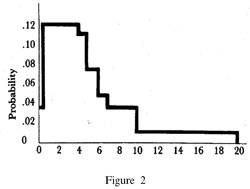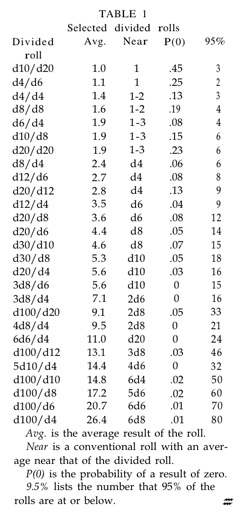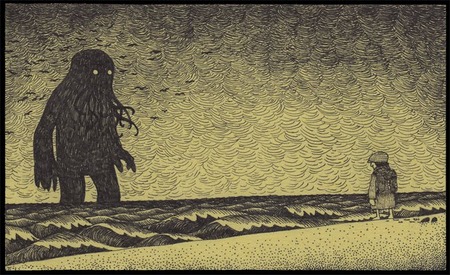More on Magic
There has been a fair amount of talk about different methods of magic in fantasy games. Vancian magic (fire and forget) is really treating spells like artillery shells- only a limited number of them, and when they run out the fearsome magic user is suddenly just a weenie in a bathrobe. So being a magic user becomes a minigame in resource management... how to use your limited arsenal most effectively.
Spell points aren't much different, except that they are more flexible. Now the spells are like guns, and the magic user has to decide which gun to fire his limited supply of bullets through. More flexible and easier to grasp, (especially if you have played a fantasy video game or MMORPG) but also kind of generic.
Magic is in essence a mage hacking reality (According to White Wolf anyway) so each spell should be a fundimentally different tacktic. But why should the mage not be able to repeat that trick again. But if a magic user is able to bend reality to his will anytime he wants, then why wouldn't he?
Call of Cthulhu (which used the spell point system) had the additional counter balance of sanity loss when fiddling around with magic. And there have been systems that have significant risks from spells backfiring, although I am not thinking of any titles off hand.
One option would be a modified Vancian system where a mage has to roll a saving throw after every time they cast a spell a day. They throw a d6 for how many times they have cast it that day, (including the current casting) and then if they get a total of 6 or more then they 'hit the wall' and cant' cast it again till they rest. Either mental exhaustion, or some sort of abstract power is used up... or maybe the tiny demons on the other side have noticed this activity and are tearing at the mage's soul.
Example: the first time a mage casts fireball, they roll 1d6, and will succeed on a 5 or less. The next time they cast it the same day, they roll 2d6, which will statistically fail (7 being the mean). The third time, they roll 3D6, etc...
One option might be to allow the mage to add the difference between their level and the spell's level to limit. (so a 5th level mage casting a 1st level spell for the 3rd time would roll 3d6 and try to get a 9 (5+4) or less.
Spell Componants
Just read Aeons & Augauries' post on Spell components, and he raises a good point. Spell components seem like a very cool mechanic, until you are into actual play, and then they become just another inventory management system the Magic user's have to manage.
What is interesting is that Vancian magic is a form of imposed scarcity, where the MU is limited to a certain number of spells per day. That way keeping the Magic user from becoming a fireball turret. Spell components are a different scarcity mechanic, in that there is a limit to carrying capacity or wealth when it comes to getting these rare ingredients.
Imposing both systems on a magic user is pretty painful, so most players seem to ignore the component rules. In 4th edition, they split into two types of magic- spells that are cast and are still pretty vancian (at least the daily powers) and then ritual magic that happens outside of combat, frequently takes days to complete, and is where the really big magic is used. For the latter, the spell components are partially a 'magic tax' on the magic user, but also offers the DM adventure hooks, if he wants to make the quest for a particular rare component a requirement to complete the ritual.
Other games approached this whole problem using spell/mana points (a more abstract form of scarcity) or Sanity loss/Darkside points (basically turning it into a gambling system, where the magic user had to gauge how far they could push their luck.)
But I do think there is something interesting in using strict spell component system, where a magic user could cast as many spells as they have the correct components. The magic user could spend money/time to gather what they will need ahead of time, but they also might be able to scavenge what they need while in the dungeon. (enemy Magic users would also need to carry many of the same components.) Thus there would be more challenge to the player to think of ways of getting what their character needed. Especially if the component is defined more generally for lower level spells, and the more powerful the spell, the more specific the requirement. (like a spell that may call for dragons blood to work at 100%, can still work at 40% power with human blood, and at 5% power if you just have something red, like wine.)
It would be on the DM to keep them in check, else you might have a Magic User with a mule carrying sacks of Fireball components into the dungeon, but mules can run off at the most in opportune moments...
Muskets & Dragons
For a project I am working on, I had the idea that this new race I wanted to create used a medieval gun as their 'High tech' attack. I figured that someone must have house ruled D&D 0ed/1ed rules for firearms. (Many people have, and more then a few 'firefights' have broken out between the 'lets add guns' and the 'guns are NOT D&D' camps. oy.) Anyway, after reading the boards, I was referred back to Dragon issue #70 where Ed Greenwood took a stab at it for AD&D 1Ed. (He also had addressed canons and other field pieces on an earlier article in issue #60.)
While enlightening, the fact that it was for AD&D made it not an off the shelf solution for OD&D. Also there were some guns mentioned in the Blackmoor supplement, but (spoiler) those were ray guns from amphibious aliens hiding under a swamp. Plus many people have taken their stab at how to come up with the rules- I still need to read the rules that were published in Oubliette Magazine). Most of this focuses on the greater damage guns do, and also the possibility of the gun blowing up in the firer's face. (Something for the player, and something for the DM, if you will.) Many of the solutions also come up with rules to govern range, reload time, and armor penetration.
For 0ed/1ed/S&W/LL I am not too interested in adding additional rules, since the streamlined-ness of the original rule set is one of its attractions. So no additional rules unless absolutely necessary.
Option 1: Pure flavor
The simplest option is to simply take the rules for crossbows and keep them intact, and simple let the player go 'bang' instead of 'twang'. Heavy crossbow is the same as a musket, and a light crossbow is the same as a pistol. Easy, but makes me ask 'why bother?'
Option 2: some new contingencies
Since on the original rules, the damage dice don't change between different weapons, having the bullet do more damage then the crossbow is a little suspect. Anyway, I think the advantage of the gun wasn't its damage over range capability, but instead its armor piercing capability. Which in these rules is governed by the to Hit rules. (since a higher to hit counteracts the defender's AC better) So perhaps a firearm is simply a +1 or +2 version of the crossbow mechanically that is also non-magical.
In addition to that, perhaps we can allow an optional rule where if the player rolls a '1' on their to hit roll, there is a hang fire, with a possibility of it blowing up in the firer's face. (roll a d6 and on a 1 it backfires. on a 2-6 it is simply jammed and can't be fixed while in combat unless the DM decides otherwise.)
As far as rate of fire, I am inclined to think that it is like an encounter power in 4E- that combat is usually too fast and furious to bother with reloading, so you fire once and then switch to the trusty sword or axe. that avoids the whole reload issue. But the rule that it takes one turn to reload, and one turn to aim and fire, might work. Or maybe it needs to be slower. (not sure if reloading & cocking a heavy crossbow is faster or slower then reloading a long arm.)
Option 3: Exploding die
So on the other hand, lets say that we really want the possibility of a headshot with the old gun. Its just cool when you pull it off. A head shot is typically an instant kill mechanic. Some of the solutions I have seen use a hit location table mechanic, (but simple, such as roll a d6 with 1=left leg, 2=right leg, 3=torso, 4=left arm, 5=right arm, 6=head) and then based on which of those you roll, the damage is multiplied based on some rule (limbs are 1x, torso is 2x, and head is 3x your damage roll)
But all of this is a way of saying that sometimes you get bonus damage, since enemies are not homogenous lumps of flesh (except the oozes, gelatinous cubes, shoggoths, etc.) A simpler mechanic is the exploding die, where if you roll your max, you get to roll it again. some rules even let you keep going as long as you keep rolling the max damage on the die.
So by using something like that, the DM can then look at the total damage done, and then describe what happened appropriately. (if someone does enough points of damage to instantly kill a foe, then the DM probably would say you got them right between the eyes.)
Option 4: Divided Rolls
 Statistical roll probability for a d20/d4A more math nerd approach then that would be to use a 'Divided Roll'. I came across a very interesting article in Dragon issue #94 about divided die rolls by David G. Weeks called Same Dice, Different Odds which explained this approach. He basically shows that by using two dice where one is divided by the other you can get a asymmetrical probability curve. Depending on the dice you use you can get a very long tail profile. A simple application of this could be where rather then using a hit location table, you simply have the damage roll be a d20/d4. He shows that the average damage of such a roll is 5.6, which is pretty close to that of a regular 1d10. But if the player rolls a 20 on the d20, and a 1 on the d4, then they do 20 points of damage. (20/1=20)
Statistical roll probability for a d20/d4A more math nerd approach then that would be to use a 'Divided Roll'. I came across a very interesting article in Dragon issue #94 about divided die rolls by David G. Weeks called Same Dice, Different Odds which explained this approach. He basically shows that by using two dice where one is divided by the other you can get a asymmetrical probability curve. Depending on the dice you use you can get a very long tail profile. A simple application of this could be where rather then using a hit location table, you simply have the damage roll be a d20/d4. He shows that the average damage of such a roll is 5.6, which is pretty close to that of a regular 1d10. But if the player rolls a 20 on the d20, and a 1 on the d4, then they do 20 points of damage. (20/1=20)
To simulate a d6 damage with a nice log tail for the possible headshot for the gun, a d20/d8 comes pretty close. It averages 3.6 damage, but can go up to 20. That seems like a lot, however 95% of the time it will be a 12 or less, so those 20 point headshots are only about a 1 in 80 occurrence.
Anyway, it is worth it to track down the full article written by David G. Weeks, he does an excellent job of breaking down how the math works. But here is the table of the various combinations of dice he mapped out, that may be of use playing around with divided rolls.

Crutch vs. Flavor
So I have been reading up on a bunch of different systems, especially rules-lite systems. (both the classics and the new wave versions.) and seeing the various ways gameplay and simulations of the game world are modeled through game rules have been very illuminating.
It's pretty clear that all RPGs fall on a continuum of how many rules the designer thinks are necessary. And over time there is a clear tendency for more rules to be created and added onto a game. No surprises there.
So we can look at the inital rule set for a game (before it has begun to be 'patched' with additional rules) as what the designer originally thought was needed for the game to function. I suspect that a lot of self published games start off as the GM's own set of house rules, that he decides work better then what is already out there and so chooses to publish them as a new game. So I think that those initial rules are a pretty good picture of how they RAN their own game- the rules they decided were necessary based on their own gaming group's dynamic. (there are alot of problems with this though, since I am sure many game designers look at what other games include as 'required' rules when creating their own game. But the gist of my thought is that the areas they chose to expand the rules were the most contentious areas in their own game.)
If you look at RPGs without rules have no constraints, and can devolve into squabbaling along the lines of every game of Cowboys and Indians ever played for more then 10 minutes. But I am sure there are Master GMs who can make it work- they have the player's complete trust and are able to act as master storytellers who keep the game flowing without dice or rules.
But they are a rare and mythological breed. For us mortal GMs, at the very least we need a combat/task resolution system. Something that impartially answers the question of 'Did I succeed?'. Again there are many talented and experienced GMs who can create multi-year campaigns where the players have epic adventures, all with that one simple mechanic agreed upon.
But again, players are sneaky folk, and they might realize that they can redefine their character to succeed more often, annoying the other players. So the character sheet is created as a social contract between the players that they will keep their character consistent and not make unfair changes. Now we have a level playing field and some rules- this is looking less like a story and more like an actual game.
Of course a game can also be won, if you figure out the constraints and find the spots to exploit.
From here the options explode into a multitude of directions, with various rules being added to patch the weak spots, which them themselves later need more patching. Eventually you end up with one of those games with a encyclopedia of rules that aims to account for every eventuality.
My point to all of this, is that rules are a crutch to overcome a GM's fallibility. Now, no GM is infallible (certainly not me,) so this is not a statement of me saying we need more freeform gaming. Its more the idea that whenever contemplating adding a new rule to a game system, one should think of it as adding a crutch to fix something the GM is having a hard time handling by fiat.
Is it easier to create another rule that needs to be remembered, or use your GM skills to simply handle it in game?
